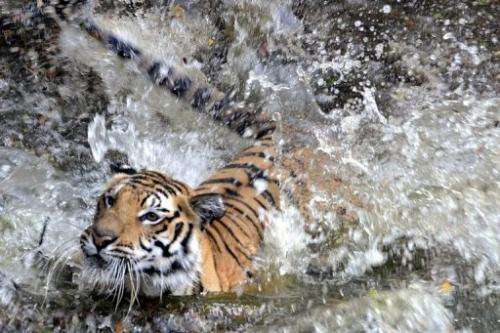A Royal Bengal tiger splashes into a pond at the Nehru Zoological Park in Hyderabad, India on April 23, 2010. Nepal's number of Royal Bengal tigers in the wild has soared 64 percent to 198 in just four years, according to a government survey released Monday.
Nepal's number of Royal Bengal tigers in the wild has soared 64 percent to 198 in just four years, according to a government survey released Monday.
Experts attributed the rise to a crackdown on poaching as the government vowed to double the number of tigers in the wild by 2022.
"The survey has found the number of adult tigers in the wild is now 198," conservation minister Tek Bahadur Thapa Gharti said in Kathmandu.
"We have pledged to double this number by 2022," he told reporters.
The report's release at a meeting in the Nepali capital coincided with World Tiger Day.
Conservationists said the sharp increase from 121 tigers counted in a similar survey in 2009 was due to tougher action against poachers and better management of tiger's habitats.
"Law enforcement played a vital role," said Maheswar Dhakal, a wildlife department ecologist.
Hundreds of conservationists and wildlife experts at the meeting watched images of tigers caught on camera during the survey of protected areas.
According to the survey, the Chitwan National Park in south-central Nepal alone has 120 Royal Bengal tigers.
Fifty others roam in the Bardiya National Park while the rest live in three other protected areas.
An Indian Royal Bengal Tiger yawns as he rests in the water pond inside an enclosure at the Nehru Zoological Park in Hyderabad, India on May 11, 2011. Nepal's number of Royal Bengal tigers in the wild has soared 64 percent to 198 in just four years, according to a government survey released Monday.
"The conservation areas, where the animals roam, have also increased, contributing to the rise in numbers," Dhakal said.
Around 500 cameras were placed in protected wildlife areas to carry out the tiger census, Dhakal said.
More than 250 conservationists and wildlife experts worked on the survey, which cost 35 million rupees ($367,955).
Dhakal said a parallel survey was conducted in India and the results from both countries will be published in December.
"It will take a few more months for India, which now has 1,300 Royal Bengal tigers in several huge protected areas, to finalise the results," he said
The WWF has warned that tigers worldwide are in serious danger of becoming extinct in the wild.
The number of tigers in the wild has fallen from 100,000 in 1900 to around 3,200 now, the group says.
© 2013 AFP

























